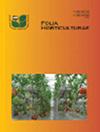Biochemical variances through metabolomic profile analysis of Capsicum chinense Jacq. during fruit development
IF 1.8
4区 农林科学
Q2 HORTICULTURE
引用次数: 3
Abstract
Abstract Capsicum chinense Jacq. is classified under the Solanaceae family, which is an extensively consumed spice and vegetable globally. Therefore, to gain more knowledge and insight into the diversity of Capsicum chinense Jacq. metabolites, a total of 18 placental tissues from various development stages were collected and untargeted metabolomics was conducted by means of ultra-performance liquid chromatography (UPLC) and mass spectrometry (MS). Principal component analysis (PCA) analysis established the existence of distinct metabolite distribution patterns as observed at 16 days post anthesis (DPA), compared with the metabolites at 36 and 48 DPA groups, whereas there was a difference in metabolites between the orange ripening period (B) and the red ripening period (C), which intersected with each other. Furthermore, several pathways including metabolic pathways, biosynthesis of phenylpropanoids, ABC transporters, alanine, aspartate and glutamate metabolism, fatty acid biosynthesis, pentose and glucoronate pathways, secondary metabolites biosynthesis, cutin, biosynthesis of suberine and wax were significantly enriched across the fruit ripening stages. The capsaicin content was observed to be less in the early ripening stages, but gradually increased to a high concentration during the late ripening stages. In conclusion, our study findings submit a suitable approach for interpreting the biochemical variances of non-targeted metabolomics in hot pepper developmental stages, as well as offer new findings that can be applied in the development strategies in breeding of Capsicum chinense Jacq.应用代谢组学图谱分析辣椒的生化变异。在果实发育过程中
摘要辣椒。属于茄科,是一种在全球范围内广泛食用的香料和蔬菜。因此,对辣椒的多样性有更多的了解和认识。采用超高效液相色谱法(UPLC)和质谱法(MS)对18个不同发育阶段的胎盘组织进行了非靶向代谢组学研究。主成分分析(PCA)分析确定,与36和48个DPA组的代谢物相比,在花后16天(DPA)观察到存在不同的代谢物分布模式,而橙色成熟期(B)和红色成熟期(C)之间的代谢物存在差异,这两个时期相互交叉。此外,几种途径,包括代谢途径、苯丙素生物合成、ABC转运蛋白、丙氨酸、天冬氨酸和谷氨酸代谢、脂肪酸生物合成、戊糖和葡糖醛酸途径、次级代谢产物生物合成、角质、木栓碱和蜡的生物合成,在整个果实成熟阶段都显著富集。观察到辣椒素含量在早熟阶段较少,但在晚熟阶段逐渐增加到高浓度。总之,我们的研究结果为解释辣椒发育阶段非靶向代谢组学的生化变化提供了一种合适的方法,并为辣椒育种的发展策略提供了新的发现。
本文章由计算机程序翻译,如有差异,请以英文原文为准。
求助全文
约1分钟内获得全文
求助全文
来源期刊

Folia Horticulturae
Agricultural and Biological Sciences-Horticulture
CiteScore
3.40
自引率
0.00%
发文量
13
审稿时长
16 weeks
期刊介绍:
Folia Horticulturae is an international, scientific journal published in English. It covers a broad research spectrum of aspects related to horticultural science that are of interest to a wide scientific community and have an impact on progress in both basic and applied research carried out with the use of horticultural crops and their products. The journal’s aim is to disseminate recent findings and serve as a forum for presenting views as well as for discussing important problems and prospects of modern horticulture, particularly in relation to sustainable production of high yield and quality of horticultural products, including their impact on human health.
 求助内容:
求助内容: 应助结果提醒方式:
应助结果提醒方式:


